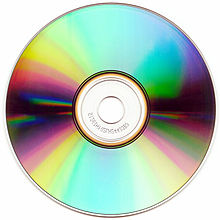
Back قرص صوت رقمي مضغوط Arabic Audio-CD Byelorussian CD Àudio Catalan Red Book Czech Compact Disc Digital Audio German CD audio Spanish سیدی صوتی Persian Red Book (norme CD audio) French CD de son Galician Zvučni CD Croatian
 | |
 | |
| Media type | Optical disc |
|---|---|
| Encoding | 2 channels of LPCM audio, each signed 16-bit values sampled at 44100 Hz |
| Capacity | up to 74–80 minutes (up to 24 minutes for mini 8 cm CD) |
| Read mechanism | Semiconductor laser (780 nm wavelength) |
| Standard | IEC 60908 |
| Developed by | Sony & Philips |
| Usage | Audio storage |
| Extended to | DVD-Audio |
| Released | 1982 |
| Optical discs |
|---|
Compact Disc Digital Audio (CDDA or CD-DA), also known as Digital Audio Compact Disc or simply as Audio CD, is the standard format for audio compact discs. The standard is defined in the Red Book technical specifications, which is why the format is also dubbed "Redbook audio" in some contexts.[1] CDDA utilizes pulse-code modulation (PCM) and uses a 44,100 Hz sampling frequency and 16-bit resolution, and was originally specified to store up to 74 minutes of stereo audio per disc.
The first commercially available audio CD player, the Sony CDP-101, was released in October 1982 in Japan. The format gained acceptance in some developed nations, selling more than a million CD players in its first two years, to play 22.5 million discs,[2] before overtaking records and cassette tapes to become the dominant standard for commercial music. Peaking around year 2000, the audio CD contracted over the next decade due to rising popularity and revenue from digital downloading, and during the 2010s by digital music streaming,[3] but has remained as one of the primary distribution methods for the music industry.[4] In the United States, phonograph record revenues surpassed the CD in 2020 for the first time since the 1980s,[5][6] but in other major markets like Japan it remains the premier music format by a distance[7] and in Germany it outsold other physical formats at least fourfold in 2022.[8]
In the music industry, audio CDs have been generally sold as either a CD single (now largely dormant), or as full-length albums, the latter of which has been more commonplace since the 2000s.[9] The format has also been influential in the progression of video game music, used in mixed mode CD-ROMs, providing CD-quality audio popularized during the 1990s on hardware such as PlayStation, Sega Saturn and personal computers with 16-bit sound cards like the Sound Blaster 16.[10][11]
- ^ "Redbook Audio (Concept)". Giant Bomb. Retrieved 28 August 2024.
- ^ Pohlmann, Ken C. (2000). Principles of Digital Audio. McGraw-Hill. p. 244. ISBN 978-0-07-134819-5.
- ^ "IFPI publishes Digital Music Report 2015". 14 April 2015. Archived from the original on 14 April 2015. Retrieved 1 July 2016.
- ^ Plambeck, Joseph (30 May 2010). "As CD Sales Wane, Music Retailers Diversify". The New York Times. Archived from the original on 1 May 2017.
- ^ "Vinyl Outsells CDs For the First Time in Decades". 10 September 2020. Archived from the original on 22 September 2020. Retrieved 22 September 2020.
- ^ "Mid-Year 2020 RIAA Revenue Statistics" (PDF). Riaa.com. Archived (PDF) from the original on 9 May 2023. Retrieved 2 June 2023.
- ^ "3 observations on… how Japan's music industry caters to (and relies on) 'superfans' more than any other market". Music Business Worldwide. 23 October 2023. Retrieved 3 May 2024.
- ^ "Statistik | Absatz von physischen Tonträgern und digitalen Musikprodukten". miz.org (in German). Retrieved 3 May 2024.
- ^ "1999: The Year the Record Industry Lost Control". theafterword.co.uk. Retrieved 3 May 2024.
- ^ Collins, Karen. From Bits to Hits: Video Games Music Changes its Tune. School of Music, University of Windsor.
- ^ "Group Test: 90MHz Pentiums - Sound cards". Personal Computer World. Vol. 18, no. 9. September 1995.